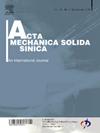Experimental Study on Strain Transfer Behavior of Graphene and Black Phosphorus Heterostructure on Flexible Substrate
Abstract
The strain transfer behavior of graphene and black phosphorus heterostructure on flexible substrates plays a crucial role in the functionality and regulation of the device. Specifically, it is imperative to investigate the anisotropy associated with strain transfer at the black phosphorus interface. In this study, a sample transfer method was proposed to prevent the contact of black phosphorus with water, achieving monolayer graphene and few-layer black phosphorus heterostructures on a PET film substrate. Micro-Raman spectroscopy was used to measure the strain of graphene and black phosphorus when the PET film substrate was under uniaxial tensile loading along the zigzag and armchair directions of black phosphorus, respectively. The Raman shift-strain relationship of black phosphorus was derived, and an interface transfer model was developed for the heterostructure. Based on the model, the strain transfer efficiency of each measuring spot was calculated and the strain transfer mechanism of each layer was analyzed. The results uncover the influence of the anisotropic interlayer properties inside the black phosphorus on the strain transfer behavior in the heterostructure on the flexible substrate.

 求助内容:
求助内容: 应助结果提醒方式:
应助结果提醒方式:


